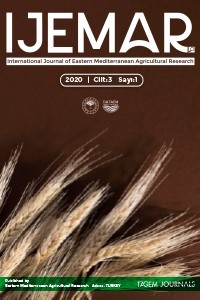Isolation of Fungus From The Cadaver Storage Pool
Fungi made from samples taken from the ambient air of the cadaver storage pool and anatomy laboratory containing formaldehyde, Purpureocellium lilacinum, Penicillium verrucosum, Aspergillus flavus, Trichophyton verrucosum, Trichophyton tonsurans, and Fusarium spp. isolated and identified. In these cases, those grown formaldehyde fungi, which are used for the fixation of cadavers and the preservation of their structures, show that they should be constantly controlled in the cadaver pools. In addition, it is emphasized that the detected fungal agents may pose a risk in terms of health due to their zoonotic character.
Anahtar Kelimeler:
Formaldehit, hayvan, kadavra, mantar., animal, cadaver, formaldehyde, fungi.
Fungus Isolation And Identification From The Cadaver Tank
Formaldehit içeren kadavra tanklarından ve anatomi laboratuvarının ortam havasından alınan örneklerden yapılan mantar analizleri sonucunda Purpureocellium lilacinum, Penicillium verrucosum, Aspergillus flavus, Trichophyton verrucosum, Trichophyton tonsurans ve Fusarium spp. izole ve identifiye edilmiştir. Bu olgu ile birlikte anatomi eğitiminde kullanılan kadavraların fikzasyonu ve yapılarının korunması için kullanılan formaldehitin, fungisidal etkinliğinin, havuzlarda sürekli kontrol edilmesi gerekliliğini göstermektedir. Ayrıca tespit edilen mantar etkenlerinin zoonotik karakterde olması yönüyle sağlık açısından risk teşkil edebileceği de vurgulanmaktadır.
Keywords:
animal, cadaver, formaldehyde, fungi.,
___
- Afshari, M. A., Riazipour, M., Kachuei, R., Teimoori, M., Einollahi, B. (2013). A qualitative and quantitative study monitoring airborne fungal flora in the kidney transplant unit. Nephro-Urology Monthly 5 (2): 736-740.
- Agnetti, F., Righi, C., Scoccia, E., Felici, A., Crotti, S., Moretta, I., Moretti, A., Maresca, C., Troiani, L., Papini, M. (2014). Trichophyton verrucosum infection in cattle farms of Umbria (Central Italy) and transmission to humans. Mycoses 57 (7): 400-405.
- Al Aiyan, A., Barigye, R., Mohamed, M., Menon, P., Hammoud, M., Richardson, K. (2018). Microbial status of animal anatomical cadavers fixed using low formaldehyde concentrations. Journal of Veterinary Anatomy 11 (2): 1-16.
- Cafarchia, C., Paradies, R., Figueredo, L. A., Iatta, R., Desantis, S., Di Bello A. V. F. Zizzo, N., Van Diepeningen, A. D. (2020). Fusarium spp. in Loggerhead Sea Turtles (Caretta caretta): From colonization to infection. Veterinary Pathology 57 (1): 139-146. Elshaer, N. M., Mahmoud, M. E. (2017). Toxic effects of formalin-treated cadaver on medical students, staff members, and workers in the Alexandria Faculty of Medicine. Alexandria Journal of Medicine 53 (4): 337-343.
- Kapoor, P., Sharma, P.K. (2020) Potential health hazards of formaldehyde usage in gross anatomy dissection hall on students and instructors. Era's Journal of Medical Research 7 (2): 235-238.
- Kidd, S., Halliday, C., Alexiou, H., Ellis, D. (2016). Descriptions of medical fungi (3th b.). David Elli, South Australia.
- Kondo, T., Morikawa, Y., Hayashi, N. (2008). Purification and characterization of alcohol oxidase from Paecilomyces variotii isolated as a formaldehyde-resistant fungus. Appied Microbiology Biotechnology 77 (5): 995-1002.
- Luangsa-Ard, J., Houbraken, J., Van Doorn, T., Hong, S. B., Borman, A. M., Hywel-Jones, N. L., Samson, R. A. (2011). Purpureocillium, a new genus for the medically important Paecilomyces lilacinus. FEMS Microbiology Letters 321 (2): 141-149.
- Minemura, A., Kitamura, R., Sano, M., Osawa, S. (2015). Degradation of formaldehyde by Aspergillus oryzae. Japanese Journal of Water Treatment Biology 51 (3): 69-74.
- Rostami, N., Alidadi, H., Zarrinfar, H., Salehi, P. (2016) Assessment of indoor and outdoor airborne fungi in an Educational, Research and Treatment Center. Italian Journal of Medicine 11 (1): 52-56.
- Sáenz, V., Alvarez-Moreno, C., Pape, P. L., Restrepo, S., Guarro, J., Ramirez, A. M. C. (2020). A one health perspective to recognize Fusarium as important in clinical practice. Journal Fungi (Basel, Switzerland) 6 (4): 235.
- Sahab, A., Mounır, A., Hanafy, O., et al (2019). Antifungal activity of some selected fumigants regularly used against fungi isolated from repository of Dar- Al-Kottob Of Egypt. International Journal of Conservation Science 10 (2): 307-316.
- Samanta, I. (2015). Veterinary Mycology. Springer, India.
- Sawada, A., Ikeda, R., Tamiya, E.,Yoshida, T., Oyabu, T., Nanto, H. (2006). A novel formaldehyde-degrading fungus, Trichoderma virens: isolation and some properties. IEICE transactions on electronics 89 (12): 1786-1791.
- Tišler, T., Zagorc-Končan, J. (1997). Comparative assessment of toxicity of phenol, formaldehyde, and industrial wastewater to aquatic organisms. Water, Air and Soil Pollution 97: 315-322.
- Ünsaldı, E., Çiftçi, M. K. (2010). Formaldehit, kullanım alanları, risk grubu, zararlı etkileri ve koruyucu önlemler. Yüzüncü Yıl Universitesi Veteriner Fakültesi Dergisi 21 (1): 71-75.
- Walsh, T. H., Hayden, R. T., Larone, D. H. (2018). Laboratory Technique. Larone's Medically Important Fungi : a Guide to Identifiaction (6th b., s. 359-456). ASM Press, USA.
- Yu, D. S., Song, G., Song, L. L., Wang, W., Gun, C. H. (2015). Formaldehyde degradation by a newly isolated fungus Aspergillus sp. HUA. International Journal Environmental Science Technology 12: 247-254.
- Yu, D., Song, L., Wang, W., Guo, C. (2014). Isolation and characterization of formaldehyde-degrading fungi and its formaldehyde metabolism. Environmental Science Pollution Research International 21: 6016-6024.
- ISSN: 2667-5102
- Yayın Aralığı: Yıllık
- Başlangıç: 2018
- Yayıncı: Eastern Mediterranean Agricultural Research Institute
